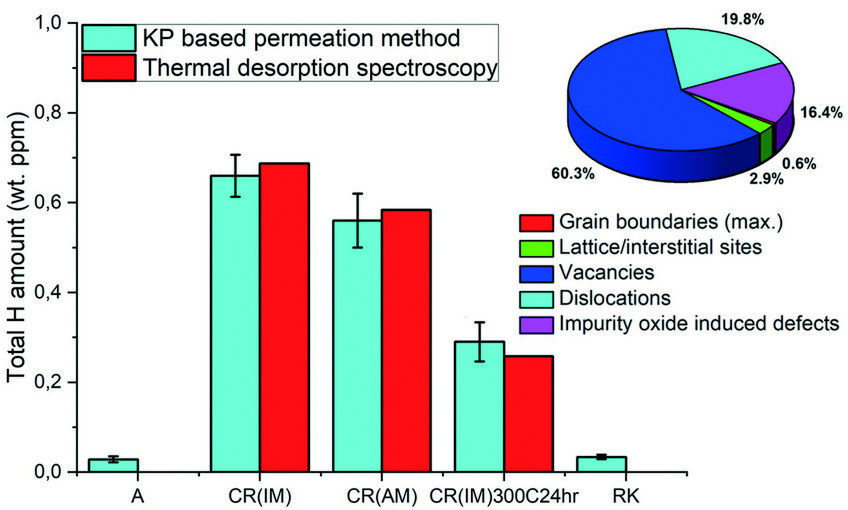Scanning Kelvin Probe for advanced measurement of hydrogen and electrochemical activity at buried interfaces
The utilization of Kelvin Probe (KP) techniques for spatially resolved high sensitivity measurement of hydrogen has been a major break-through for our work on hydrogen in materials. A relatively straight forward approach was hydrogen mapping for supporting research on hydrogen embrittlement that was successfully applied on different materials, and this cooperation was continued, see e.g. [1, 2].
The key strength of this KP approach for H mapping is that the hydrogen release from the investigated material into an ultra-thin palladium detection layer is directly measured with high local resolution. This release rate is a measure for how fast H can be supplied e.g. to a crack tip. Hence, this measured H activity is more relevant than just the local concentration of hydrogen without information of how strongly it is trapped. However, information related to different local distribution of hydrogen activity can only be resolved if the release of features at the surface is larger than the global background release from the bulk. For materials with very fine microstructure which have been loaded with hydrogen to a depth much larger than the average length scale of this microstructure, local differences of the hydrogen release rate are averaged out as long as the hydrogen activity in the loaded region is still relatively high.
To solve this problem is one main focus for the further development of SKP- force microscopy (SKPFM) for mapping hydrogen activity and permeation. In order to be able to identify local differences and especially also trap sites with moderate and even low release rates of the trapped hydrogen, this global background has to be significantly lowered. One possible approach that is investigated is ultra-short hydrogen loading prior to the measurements, another one, which is currently favoured, is the thinning-out of the materials to ultra-thin slabs, thus reducing hydrogen supply from the bulk. A procedure for this is currently elaborated for use on various materials and will be made available in the recently established Hydrogen Lab.
Since often the evaporation of a thin Pd film and providing a dry nitrogen atmosphere is inconvenient or even impossible (such as in the field), alternatives are currently being investigated. Hence, another important activity is trying to provide an understanding of the potential distribution measured on the surface of not Pd coated materials. Depending on the H activity in the material the potential of the surface oxides can be either directly correlated to an electrochemical equilibrium of the oxygen reduction reaction (ORR) and the hydrogen oxidation reaction (HOR) on the surface of the oxide, just as it was observed on the surface of Pd (see e.g. [3]), or it may just be correlated to the oxide forming in the presence of high hydrogen activity directly after termination of the hydrogen loading procedure. This will depend on the kind of surface oxide as well as on the hydrogen activity prevailing directly upon termination of loading and is object of intense current research.
Another application, rather of SKP than SKPFM, is for substituting the standard Devanathan-Stachurski approach for permeation measurements. A huge advantage of the Kelvin Probe based approach is that it is sufficient to evaporate an ultra-thin Pd film on the exit side, which is much easier to achieve than the usually required electrodeposition of a well-adhering and pore-free palladium coating. As could be quite impressively demonstrated the KP-based permeation method can indeed provide fully quantitative information (see fig.1).

This approach is made available in the Hydrogen Lab. Current research on this application is focussed now on realizing Kelvin Probe based permeation measurements also at different temperatures.












